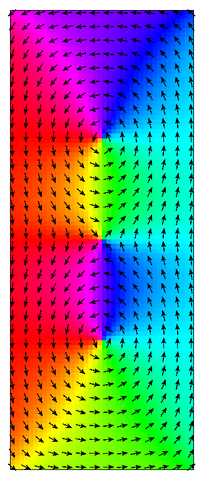Summary
Micromagnetics concerns the patterns of magnetization that arise in materials on the scale of nanometers. Understanding these structures is key to technologies such as information storage, spintronics, and sensors as well as to the use of magnetism to probe material properties at the nanoscale. Micromagnetics approaches these matters with the tools of mathematical analysis and computer simulation.
The Micromagnetic Modeling Activity Group (µMAG) is the worldwide collection of researchers interested in the development, validation and use of micromagnetic modeling software, coordinating their joint activities via an electronic mailing list.
Description

µMAG advances the state of the art in micromagnetic modeling by establishing and maintaining communications among interested researchers, by defining a collection of standard micromagnetic problems, and by leading the development of a public reference implementation of micromagnetic software.
Communications
µMAG members use the mailing list to exchange questions and answers about the physics, mathematics, programming and software use in their micromagnetics work. The list is also used to coordinate standard problem and reference software efforts.
Standard Problems
µMAG efforts towards the validation of quality of micromagnetic modeling software are centered on the definition, publication, and exchange of solutions to a set of standard problems. When multiple micromagnetic modeling packages produce the same solutions, confidence is increased that these packages perform proper computation of the physics in question. When there are differences, more detailed comparisons can discern the origin of these differences, whether they arise from programming error, differing levels of precision in approximations, differing precisions achieved by differing choices of algorithms, differing mathematical representations of the physics under study, or some other cause. The lessons learned from these comparisons raise the quality of micromagnetic modeling software generally, and provide empirical guidance to the matching of particular modeling and programming choices to particular problems to be solved.
Reference Software
µMAG members have freely distributed a number of micromagnetic software packages. Among these, OOMMF is structured as an extensible framework where a problem is solved by a collection of modules assembled on demand. These modules may be independently developed. The ability to directly compare modules providing alternative implementations of particular modeling tasks within a common framework makes OOMMF well-suited to the task of discerning the origin of differences among the solutions computed by different micromagnetic packages. In addition, OOMMF is a useful micromagnetic package in its own right, and is widely used by micromagnetics researchers.
Recent and Current Work
Collaboration with UCSD has produced a port of OOMMF for computing on massively parallel GPUs. Ongoing work aims to revise OOMMF's extension interfaces so that port can be achieved as an independent extension. Other development work has improved OOMMF performance on multicore, high memory bandwidth systems to make calculations of billion-spin systems feasible. With high spatial resolution simulations and an extended precision numerics library, ongoing work seeks to identify and quantify sources of computational error.
OOMMF has also been made available online with the nanoHUB service.

